Tired of the stale cookie-cutter designs that make all laptops look basically alike? You’re not alone. A group of intrepid designers and engineers is doing something about the “sameness syndrome” that permeates notebook design. They’re working on groundbreaking concept designs that not only turn heads but also point to new ways to work and play on the road.
Just as car shows give us a sneak peek into the next big thing in automotive technology, concept and prototype designs provide a crystal ball to see what tomorrow might have in store for mobility.
Related stories
One laptop per student : A pre-requisite to a 21st Century public education
iPad beats laptops for air travel scenarios
Cool tips n’ tricks to liven up your laptop
New netbooks blend “best features” of laptops, smartphones
“Design concepts allow us to stretch our imaginations and ask ‘what if,’ ” says Murali Veeramoney, head of the concept PC program at Intel’s Santa Clara, Calif., headquarters. “They help us see the future of computing.”
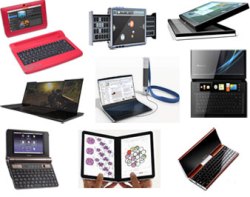
Concept laptops
Get ready for a revolution in notebook design, including laptops with multiple screens or slide-out keyboards as well as computers that can be folded into different shapes or even rolled up when not in use. How about a laptop that can be charged without being plugged in? Even the definition of “laptop” is changing, with lines blurring among traditional notebooks, netbooks, convertible tablets, iPad-style slate tablets, smartbooks, e-readers, ultramobile PCs and other mobile Internet devices.
A couple of years back, I took a look at what kind of notebooks we might be using in the year 2015, but they required a technological breakthrough or two to become reality. In contrast, the 12 innovative notebook designs here — some actual working computers, others wooden mockups or CAD drawings — are for the most part producible within the next two years.
“Folding screens, wireless charging, rollup computers — it’s all coming in the next couple of years,” says Leslie Fiering, a research vice president at Gartner. “Designers are getting more and more creative and innovative.”
Here’s a peek at the not-so-distant future.
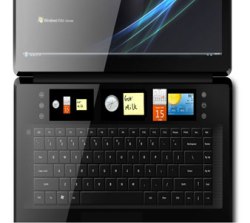
Three tiny auxiliary touch screens appear above the Tangent Bay’s keyboard.Four screens, no waiting
What if your next notebook had two, three or even four displays, each capable of making your computing experience more enjoyable and efficient? That’s the idea behind the Tangent Bay laptop created by Veeramoney’s notebook prototype group at Intel.
A full working computer that shows the possibility of fresh thinking on screens, the Tangent Bay has a prominent 15.6-in. main display along with three auxiliary 3.5-in. OLED touch screens, which are usually used on cell phones.
Evenly spaced just above the keyboard, these auxiliary displays can be dedicated to specific tasks so that the main screen doesn’t get crowded with a plethora of panes and menus.
They’re good for anything from showing a reminder note or running a live RSS feed to displaying a clock or Photoshop’s brush menu. With a little programming, Veeramoney says, you could even stash your Windows 7 Gadgets there. Personally, I would use the smaller screens to monitor my e-mail and favorite Web sites without cluttering up the main screen.
“Call it extreme multitasking, but people have multiple things going on,” explains Veeramoney. “If you want to bring any of them to the main screen, just flick it upwards with your finger. Touch is a very exciting concept for us.”
When the Tangent Bay was introduced at last year’s Intel Developer Forum in San Francisco the response was enormous. People immediately got it and saw that the multiple screens can keep several snippets of information front and center without overwhelming the user.
With an ultra-low-voltage processor inside, Tangent Bay is about as thick as a current mainstream business notebook, but slightly heavier due to the extra displays. The best part is that this system requires no new technology or engineering advances and could be made today.
“The goal of our work is commercialization,” adds Veeramoney, although commercial restrictions prevent him from talking about any plans Intel might have to bring this technology to market.
Often, these prototypes are looked over by several notebook manufacturers, which take pieces and ideas and incorporate them into their wares. Tangent Bay probably won’t see the light of day as a single model, but it will likely live on in several future notebooks from multiple makers.
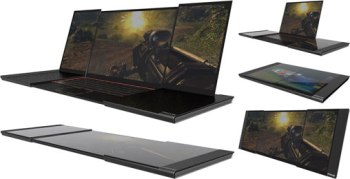
The Prime was designed with versatility in mind
Transformer
Kyle Cherry’s Prime concept takes displays a step or two further. Prime was designed to be the ultimate gaming notebook with three big screens; it can be folded up into a small and portable package for travel.
“I wanted something that could transform from small to large, depending on what you had to do,” says Cherry, a Seattle-based independent industrial designer. “Prime offers the best of both worlds.”
Currently nothing more than a CAD image, Prime would be made of six aluminum wings — three with display screens, one with a mechanical keyboard, and two blank surfaces for storing electronics. Some of Prime’s panels are hinged, and others can slide over each other. Like a Transformer toy, it can be formed into several different configurations, each with a distinct computing personality.
If you want a big-screen notebook, the Prime can be folded to create a 22-in. composite display with a wide and short 32:10 aspect ratio. You can also fold down the side screens and use only the 15-in. center screen that has a traditional 4:3 aspect ratio. Or rearrange the panels to create a huge touch-screen tablet with a wide-open workspace. When it’s time to go, all the panels fold up to the size of a traditional 13-in. system.
The multiple screens have a downside: Wherever two screens meet, there will be a thin black strip between them for the display frames, which may be distracting. (While of course I couldn’t get my hands on the Prime, I have tested a notebook with a pull-out auxiliary screen, Lenovo’s ThinkPad W700ds. Initially I found the black strip between screens annoying, but I quickly got used to it and hardly noticed it.)
Inside the Prime is room for a pair of processors and the kind of graphics engine seen only on top-of-the-line mobile workstations. The Prime’s aluminum skin will help dissipate the heat from its high-end hardware without burdening it with too many cooling fans.
“It’ll be fairly thick but will be a monster portable workstation ready for anything,” Cherry says.
At this time, no laptop manufacturers have signed up to make the Prime, but it is producible today without any technological breakthroughs. Cherry thinks the use of aluminum will keep the weight down to about 5 pounds — quite optimistic given all the displays involved. Also optimistic is its target price: $3,000.
Fold here
In contrast, the Asus Airo Origami notebook concept is as slender as it gets. When closed, Airo Origami looks like a conventional laptop, but with a razor-sharp front edge and a triangular profile. Instead of having a hinged screen lid with a stationary keyboard below, the system has four major parts that move independently: the display, the wrist rest, the bottom corner of the base and the keyboard, which slides into position as the lid is opened.
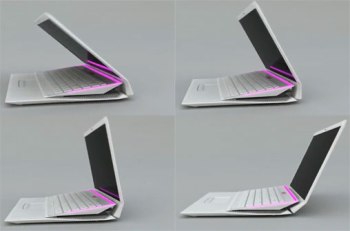
The Airo Origami’s keyboard slides up into place as the lid is opened, leaving a gap underneath for ventilation.
As its name implies, folding is the key concept here. It is a marvel of packaging that looks like a mechanical ballet when the pieces are moving into place
The Airo Origami can sit like a traditional notebook with upright screen or fold flat like a tablet on a table top. Designed to encourage collaboration, two or more systems can be linked either upright or folded flat so workers can cooperate on a project face to face across a table. (Personally, I have enough trouble keeping track of what’s going on with my own computer, much less having to deal with four or five PCs interacting.)
Asus made a working model of the design that was ready for production late last year but has since decided not to manufacture this unique notebook, saying that the company could deliver many of the Airo’s features in its mainstream laptops at a lower price. The Asus G73Jh gaming notebook, for instance, has a similarly angled keyboard with cooling vents underneath.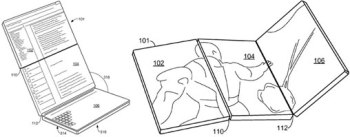
The Multi-Fold can be bent into a variety of configurations.
Folding also dominates a futuristic ultramobile device called the Multi-Foldthat is being patented by Qualcomm. The system is composed of three display panels, like a triptych that can be arranged to deliver different computing personalities.
It can be a wide-open tablet workspace, a travel-friendly notebook with an extra-tall screen or, at night, a device with one screen exposed that looks a lot like an alarm clock. No word on size or weight, but there’s nothing in it that can’t be made today.
It has one big drawback: no mechanical keyboard. Instead, one of the displays can be used as a screen-based keyboard. While this has the advantage of potentially setting up keys of exactly the size and shape you want, they lack the feedback and feel of a mechanical key moving under the pressure of a finger.
The key to computing
But what if the keyboard could be hidden and come out when needed? That’s the idea behind a smartbook prototype that was designed as part of Freescale Semiconductor’s SCAD Design Challenge competition. 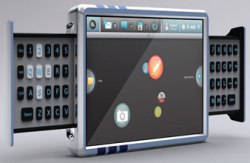
Dual pull-out screens are made for thumb typing in this Freescale/SCAD smartbook prototype
Created in cooperation with the Savannah College of Art and Design, the prototype has a pair of pull-out keyboards that straddle the screen. You hold the device in two hands and use your thumbs to type e-mails, blog posts and quickie Twitter notes.
“It blends ideas from phones and notebooks together to create a more compelling Web experience,” says Steve Sperle, head of consumer segment marketing for smartbooks at Freescale.
SCAD is a nonworking static mock-up made to test how people might react to the design, but it could be manufactured tomorrow without any new technology. With a 7-in. central screen, it won’t replace a full notebook, but at only about half an inch thick, it’s a go-anywhere device — sort of like a small iPad with physical keys to type on.
“The challenge is making the keyboard thin enough without sacrificing the feel of the keys,” says Sperle.
Slip-sliding away
Looking like an oversized slider cell phone, Sean Bovee’s Slider is a handheld computer with a 9-in. touch screen and a mechanical keyboard that slides out from underneath the screen. The display has a central pivot that rides in a recessed track down the middle of the keyboard.
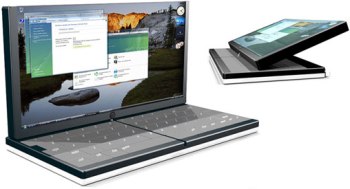
The Slider’s grooved keyboard allows the screen to slide over it for tablet-style computing.
“Slider was born out of frustration,” explains Bovee, an independent industrial designer based in Atlanta. “Why can’t we have a small machine with enough power to run the programs we want with versatility for every situation?”
At 9.5 by 5 by 1 in., Slider is designed to be small enough for a jacket pocket or bag, but powerful enough to do what you need it to do. Not an actual cell phone, Slider is equipped with a 1.5-GHz processor that enables it to handle VoIP calls as well as high-definition streaming video and video chats on its OLED screen, according to Bovee. Slider’s battery can power it for four to seven hours on a charge.
The design calls for a complete QWERTY keyboard for thumb typing or touch typing, but there’s a potential snag. Some of the keys in the center of the keyboard need to be split or downsized to accommodate the track for the screen to ride on. In other words, using the 7, Y, H and B keys might be awkward.

Intel’s Mooly Eden demonstrates how the UrbanMax’s keyboard slides out and the display lifts up to transform from slate tablet to notebook.
Veeramoney and his group at Intel built a similar prototype called UrbanMax and showed it at the Intel Developer Forum in Taiwan in the fall of 2008. The big difference is that UrbanMax has a larger screen, at 11 in., making it a bit less mobile than Slider.
Everything needed to make Slider or UrbanMax exists today, although Bovee says that to keep it slim, Slider requires a machined aluminum case and the dividing of the system’s electronics between its base and screen lid. While he declined to estimate the price, Bovee did say it would be would be more expensive than a conventional system with a plastic case.
Roll out the PC
I couldn’t resist including a concept design that isn’t quite ready for prime time: the Rolltop, a mobile computer that’s unlike anything you’ve ever seen. According to designer Evgeny Orkin, “The idea was to make a computer that could roll up and be folded into different configurations. Flexibility is what I’m after.”
While traveling, the Rolltop looks like a cylinder about the size of a roll of paper towels with a latch to keep it from unrolling en route. When it’s time to get down to work or play a game, the system is rolled out like a rug, revealing a 17-in. touch-screen tablet with a pop-out stylus for writing or drawing.
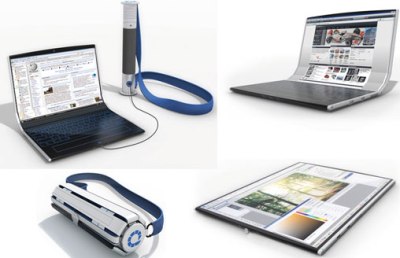
Use the Rolltop as a traditional notebook or large tablet, then roll it up to take with you.
Alternatively, the upper part of this system can be folded up to a 110-degree angle and locked into place. This transforms it into something resembling a traditional notebook with a 13-in. display on top and an on-screen keyboard below.
The secret to the Rolltop’s “rollability” is that it doesn’t have a rigid glass display, a solid case or a motherboard that integrates all the electronics. Rather, its flexible plastic screen has a series of narrow slats on the back. In between are narrow circuit boards that contain all the electronics. As the Rolltop is unrolled, adjacent slats snap together to create a solid surface. Orkin has created a video demonstrating how it works.
The ports, speakers and power adapter are housed in a cylinder that the whole thing is rolled onto when you’re ready to hit the road. There’s also a pull-out leg in the back to prop it up for use as a monitor, as well as a shoulder strap for carrying around the rolled-up computer.
“I think it will take about two years before you’ll see something like this in a computer shop,” says Orkin.
As innovative as the Rolltop is, it’s a step or two away from actually being made. The missing element is the superflexible screen, but there’s been a lot of action of late in this area — particularly in e-readers like the upcoming Skiff Reader.

The metal foil e-paper technology behind the 11.5-in. Skiff Reader is a step toward the large, ultraflexible display required to make the Rolltop real.
Rather than a rigid frame, the screen of this e-reader uses a flexible thin stainless steel backing sheet that can be bent into a “U” without cracking or breaking.
It’s a start, but it won’t bend enough to be used on the Rolltop. Also, the 11.5-in. screen, made byLG Display, is a monochrome display that won’t show color — although color should arrive in a few years.

Sony’s color OLED display can be rolled around a pencil, but it’s not laptop-size yet.
A big step forward is Sony’s flexible color OLED display that is thin enough to be rolled around a rod the thickness of a pencil. So far, the biggest screen that Sony has shown is just 4.1 in. with 432 by 240 resolution, so there’s some development still needed before it could be used in the Rolltop. Similarly, a highly bendable color LCD being developed by a consortium of Japanese tech companies is currently limited to cell-phone-size screens.
Nevertheless, with ongoing advances from these and many other sources, including HP Labs and Arizona State University, PARC, and Plastic Logic, fully flexible notebook-size displays are likely only a few years off.
Leave the keyboard at home
First shown at the Consumer Electronics Show in January 2010, Freescale’s SABRE smartbook is a crossover system that doubles as a 7-in. tablet on the road and a small netbook with keyboard at home.
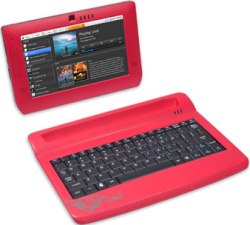
Freescale’s SABRE smartbook: 7-in. tablet on the road, desktop-like netbook at home.
The key to its design is a keyboard-based docking station that charges the system’s battery and connects it to local resources such as printers and external hard drives. “Our research showed that people wanted a smaller device than a notebook but one larger than a cell phone,” says Freescale’s Sperle. “SABRE is that computer.”
SABRE stands for stands for Smart Application Blueprint for Rapid Engineering. It’s a full working system ready for manufacturing. In fact, the prototype is intended to drum up business for Freescale’s components among Asian manufacturers, although no resellers have snapped up the SABRE design yet.
At 13 oz. and about the size of a small stack of 5-by-7-in. file cards, it’s roughly two-thirds the size and one-third the weight of today’s typical netbook. But with an ARM Cortex A8-based processor, it doesn’t skimp on power. Its performance should be on a par with that of an Intel Atom N270-based netbook, but it will use less than one-tenth the power.In addition to a battery that lasts for seven or eight hours of work, according to Sperle, SABRE offers instant-on capabilities as well as all the amenities you’d expect, such as 64GB of flash storage, USB ports and a 3-megapixel camera.
One tablet per child
While many were impressed by the ability of the One Laptop Per Child (OLPC) organization to manufacture and sell its XO educational notebook for about $200 each, its design was rather pedestrian. A follow-up fold-open tablet, theXO 2.0, never made it to production, but OLPC is now working on its successor, the XO-3.
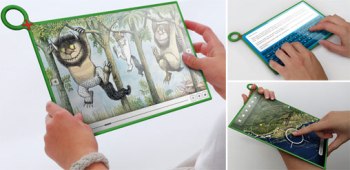
The minimalist OLPC XO-3 takes thin to a new level.
This slate tablet design trades the traditional mechanical keyboard for a 9-in. multitouch screen — a “single sheet of flexible plastic,” according to OLPC — for typing or writing with a stylus. The first working prototype, due in December, will have a glass screen, but the goal is for the shipping product to be 100% unbreakable plastic, according to project founder Nicholas Negroponte.
Other hoped-for features include haptic feedback, a dual-mode display that can be seen both indoors and in direct sunlight, and a unique corner loop for carrying the tablet between classes.
It’s extremely optimistic, but the group says that the XO-3 will cost just $75 and go on sale in 2012. (I’ll believe it when I see it.)
Two concepts that never made it …
It seems to be the routine for notebook prototypes: They’re always a year or two away from commercialization, making the world of designing and building them fraught with frustration. In fact, some of the best ideas never make it out of the lab or boardroom.
Take the Pocket Yoga, which came out of Lenovo’s Beijing design studio. A long, narrow netbook with a leather case, the Pocket Yoga resembles a large wallet when closed and can actually fit into a back pocket. The screen can be flipped over to turn the keyboard-centric system into a small slate. 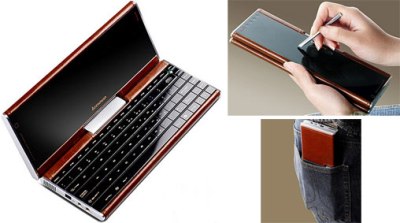
The Pocket Yoga packs a usable screen and keyboard into a netbook the size of a stenographer’s pad.
The device caused quite a stir when photos of it began popping up all over the Web last year. To the disappointment of many, however, Lenovo quickly revealed that the Yoga was nothing more than a two-year-old concept design that was never intended to be produced.
By the same token, Microsoft’s innovative Courier concept will never see the inside of an electronics store. Composed of a pair of 7-in. touch-screen displays hinged together, Courier was designed for flexibility: Hold it upright, and it’s a two-screen e-book reader or calendar. Turn it sideways, and it resembles a traditional notebook where one of the screens is a keyboard.
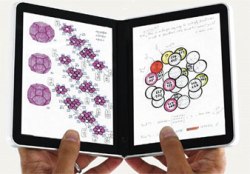
Microsoft’s Courier features two hinged touch-screen displays.While some tech watchers had high hopes that Courier might eventually become a competitor to Apple’s iPad, Microsoft recently announced that the project has been canceled. However, company officials have hinted that some of Courier’s technologies are likely to show up in future Microsoft products.
… And one concept that did make it
One of the exceptions is Sharp’sPC-Z1 NetWalker, which is based on one of Sperle’s concepts at Freescale. Looking like a severely downsized traditional notebook, this mobile internet device has a 5-in. touch screen and QWERTY keyboard.
Inside is an 800-MHz ARM processor in a handheld package that weighs 13 oz., so it can go where you go — provided you live in Japan, the only country where it’s for sale.
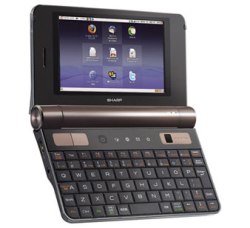
Sharp’s PC-Z1 NetWalker, available in Japan today, is based on a concept from Freescale Semiconductor.
Even if only a few of these design innovations make it into a commercial system, the future of mobility will be bright indeed. After decades of lugging too much gear or not having what I need on the road, the right system might be just around the corner.
Powering up
Finally, let’s take a look at how we might charge our amazing new laptops in the not-so-distant future. Don’t expect the conventional AC adapter to go the way of the dinosaurs. Power to run the machines and charge their batteries has to come from somewhere.
But even here, things will evolve. For example, a major part of the Rolltop prototype is that its power adapter, speakers and connections are in a cylinder that the computer is rolled onto for transit.
Most of the rest of today’s prototypes use conventional AC adapters, but George Holmes, vice president for sales and marketing at PureEnergy Solutions, has a different idea. His company’s WildCharge Pad efficiently transfers power to mobile devices. Although laptops are not on the official list of supported devices, the company says that the pad can charge a notebook or netbook.
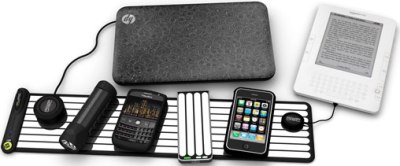
The WildCharge Pad can power up an array of devices (mostly) without wires.
The system uses raised conductive strips that move the electricity from the pad to a receiver that’s attached to the mobile gadget. PureEnergy’s hope is that hardware manufacturers will start incorporating the receivers into their products’ cases, but currently the company sells a variety of phone sleeves and other adapters with the receiver built in; some are no bigger than a coin and glue onto the bottom of the mobile device.
For now, juicing up a notebook requires the external PowerDisc. The disc isn’t actually connected to the pad (it can be moved around), but it is magnetically attracted.
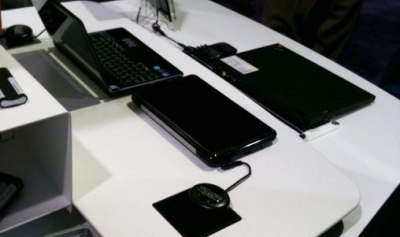
Recharging a variety of laptops with desktop charging pads.
The WildCharge Pad can simultaneously charge several phones or a single notebook, according to the company. Despite having enough power to charge a notebook on tap, the pad is safe to touch, and it can provide the right amount of power for the device(s) being charged.
But that’s just the beginning. Taking the concept a step further, PureEnergy is partnering with Kimball International to integrate the pad into desks, tables and other furniture, says Holmes. Imagine hotel rooms, airport lounges and coffee shops everywhere with charging pads built into the surfaces. Just put your notebook down on it, and power will flow to its battery.
“It’s all about convenience,” says Holmes. “This will change the way people think about power and charging their notebooks and phones.”
PureEnergy isn’t alone in its vision for a wirelessly charged future. Wireless charging pads with names like Powermat andmyGrid are cropping up left and right, and competitors such aseCoupledhave similar ideas about wireless charging.
But until notebooks and cell phones come with receivers built in — likely a year or two away — users will have to use external receivers to work with the WildCharge Pad or competing products, keeping the promise of purely wireless laptop charging just out of reach — for now.
Brian Nadel is a freelance writer based near New York and is the former editor in chief of Mobile Computing & Communications magazine.
Source: Computerworld
http://www.computerworld.com/




